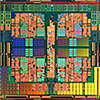by: Levi Beckerson
45nm? 32nm? Stop playing around Intel, AMD! 1nm is where it's at.

Transistors, transistors, transistors -- the building block of every processor core we know and love. The more transistors engineers can pack into a processor, the more performance they can squeeze out of it. Rather than making processors larger, incurring all sorts of evil problems, the lithography process for etching silicon wafers to create processor cores with has been refined a hundred, maybe even a thousand-fold since its inception.
Current generation mainstream processors are floating at around 45nm transistors with Intel's Penryn chips. Penryn holds about 205 million transistors per core in its die structure, with all four cores in a quad-core chip able to fit inside the area of a dime. Intel and Taiwan Semiconductor Manufacturing even boasted about 32nm cores in design as long ago as 2006.
Thus far, chip engineers have been able to keep a tenuous grasp on Moore's law, which states that the number of transistors on a microchip will double every two years. Gorden Moore, who coined the idea in 1965, feels that time is running out for his now-famous prognostication with the limits of silicon lithography rapidly approaching. Many scientists and engineers feel that 10nm will be the death knell for silicon transistors.
Worry not, readers, carbon has your back. Back in March of 2007, DailyTech reported on graphene transistors. Professor Andre Geim and Dr. Kostya Novoselov at the University of Manchester's School of Physics and Astronomy announced a transistor made of graphene that measured just one atom thick and less than 50 wide. Now, they say, they've done even better, having improved their process and created a transistor one atom thick and a mere ten atoms wide. The pair claims to have a working 1nm graphene transistor.
Obviously such a ludicrously small transistor would, possibly not revolutionize, but allow the current semiconductor industry to delve even further into chip shrinkage, packing tens or hundreds of millions more transistors into a single core, or allowing many more cores to be used in the same area as current quad-core microchips.
Combined with graphene circuitry, these new ultra-small transistors could, in fact, produce microdevices of all kinds that are much more micro than in their current lives.
All the latest research pretty much agrees, silicon is out, carbon is in. Between buckyballs, carbon nanotubes, graphene, and whatever else scientists manage to cook up from the abundant element, there isn't much that carbon can't beat silicon on. The next step in computing seems to be The C; past that, get ready for yes-no-maybe quantum computing.
